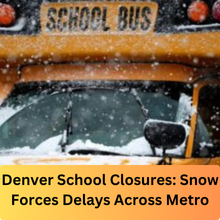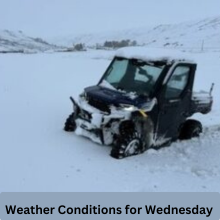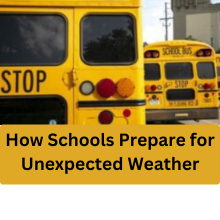
As snowstorms hit the Denver metro area, school districts were forced to announce a series of closures and delayed openings to ensure the safety of students, staff, and families. Snow accumulated heavily across the region, prompting schools to act quickly to mitigate any risks associated with hazardous weather. This article covers the school delays and closures due to snow, the impact on students and families, and how the weather situation is expected to evolve in the coming days.
The Impact of the Snowstorm on Schools
The snowstorm that blanketed the Denver area created significant disruptions in the daily routine for many families. As roads became slippery and visibility worsened, local schools prioritized safety by delaying or closing down. The snowstorm, which began overnight, continued into the morning, causing school districts across the metro area to evaluate the risks and make necessary adjustments to their schedules.
Scope of Closures and Delays Across Various School Districts
Several school districts announced closures and delays, with some areas seeing as much as 10 inches of snow. From local public schools to private institutions, no sector of the education system was unaffected. A mix of delayed openings, closures, and special arrangements for certain schools dominated the morning’s announcements.
Meteorological Context
Before diving into the specific closures, it’s important to understand the context of the snowstorm that led to these decisions. CBS Colorado issued a First Alert Weather Day, warning residents about the intensity of the storm. Meteorologists predicted anywhere between 1 to 10 inches of snow across different parts of the metro area, with the southeastern and southwestern portions receiving the heaviest accumulations. This early warning allowed schools to prepare for the worst.
Snowfall Predictions and Weather Alerts for the Region
On Wednesday, meteorologists forecasted significant snow accumulation, with varying levels across the region. Areas such as the southeastern and southwestern metro saw the highest snowfall predictions of 5 to 10 inches. Other regions were expected to see lighter accumulations of 1 to 7 inches. These predictions played a crucial role in the decisions to close schools or delay openings.
Detailed School Closures and Delays
As of 6 a.m. Wednesday, the following schools and districts across the Denver metro area were impacted by the snowstorm:
- AKRON SCHOOLS: Closed Today
- ALL SOULS SCHOOL: Delayed 1 hour, 30 minutes
- AMBLESIDE SCHOOL IN CENTENNIAL: Delayed 1 hour, 30 minutes
- AMERICAN ACADEMY: Delayed 90 minutes
- ARAPAHOE COMMUNITY COLLEGE (Castle Rock): 10 a.m. delayed start
- AVE MARIA CATHOLIC SCHOOL: Delayed 1 hour, 30 minutes
- BENNETT SCHOOL DIST 29-J: Closed Today
- BYERS SCHOOL DIST 32J: Closed Today
- CASTLE ROCK SENIOR CENTER: Closed Today
- CRESCENT VIEW ACADEMY: Closed Today
- DEER TRAIL SCHOOL: Closed Today
These delays and closures were put in place to ensure that students, faculty, and parents could avoid dangerous travel conditions caused by the heavy snow and icy roads.
Impact on Students and Parents
For many families, the announcement of closures or delays meant scrambling to adjust schedules. Parents had to make last-minute childcare arrangements, while students faced a mix of excitement and uncertainty as they learned whether or not school would be in session. However, in these cases, the safety of students is always the priority, and schools made the right call by postponing or canceling their schedules.
Weather Conditions for Wednesday
The snowstorm intensified as the morning progressed. As expected, snow accumulation continued, causing roads to become slick and hazardous, particularly in areas closer to the city. With snow already starting to accumulate by 6 a.m., school districts couldn’t risk keeping children on the roads during peak storm hours.
Snow Accumulation Predictions
CBS Colorado’s forecast indicated that snow accumulation would be substantial across the metro area. While specific amounts varied by location, the general forecast was for snow to accumulate between 2 and 10 inches throughout the day. Areas near the southeastern part of the metro, such as Castle Rock, could see the most significant snowfall. This led to decisions by school districts to take proactive steps in closing or delaying the start of classes.
Timing and Duration of the Snowstorm
The timing of the snowstorm was another factor in the closure and delay decisions. The heaviest snow was expected to fall between 9 a.m. and 3 p.m., which is right when students would typically be heading to school or returning home. For parents and school administrators, these weather patterns made it clear that safety was the priority, leading to closures and delays.
The Long-Term Weather Forecast
Although the snowstorm was intense, the end of the week brought some hope for better weather conditions. However, another wave of winter weather was expected to affect the region on Thursday and Friday, with lighter snow showers and unpredictable conditions potentially causing additional disruptions.
Thursday and Friday’s Weather Outlook
On Thursday, lighter snow was expected across the region, with a 50% chance of snow in some areas. Temperatures were predicted to hover around freezing, which could create icy conditions overnight. By Friday, the forecast shifted to a mix of rain and snow, making the weather unpredictable for the morning commute.
Risks and Uncertainties for the Weekend
The forecast for the weekend was similarly unpredictable, with a slight chance of rain and snow showers on Saturday. School districts may need to make further adjustments depending on how the weather evolves, as safety remains the top concern.
How Schools Prepare for Unexpected Weather
Making weather-related decisions can be challenging for school districts. Weather forecasting is never an exact science, and the potential for sudden changes in conditions means that districts must be prepared for last-minute adjustments.
How School Districts Make Decisions on Closures and Delays
School districts rely on a combination of meteorological data, road conditions, and safety assessments when making decisions about closures and delays. In many cases, superintendents, principals, and transportation departments work together to evaluate how severe the weather is, checking both local forecasts and real-time reports about road conditions.
Also read: Tesla Stock Jumps 15%—Musk’s Big Win with Trump in Office
The Role of Weather Forecasting in These Decisions
Meteorological alerts, like CBS Colorado’s First Alert Weather Day, provide valuable guidance for school districts. Early warnings help districts plan and communicate delays or closures effectively to students, parents, and teachers. Accurate weather predictions are essential in keeping families informed.
The Importance of School Safety in Severe Weather
Above all, school districts take these measures seriously because student and staff safety is paramount. In times of extreme weather, school administrators must make tough decisions to ensure that no one is put in harm’s way.
Transportation Issues During Snowstorms
One of the key factors that influence the decision to close or delay schools is the ability to transport students safely. School buses, which are designed for such situations, still face challenges on icy and snowy roads. In addition, traffic delays and the risk of accidents on major routes create further hazards.
Virtual Learning in Cases of Extended Closures
In cases where snowstorms result in extended school closures, many districts have turned to virtual learning. This has become a more common solution for ensuring that students don’t fall behind in their lessons while also keeping them safe at home. Virtual learning helps maintain a sense of normalcy during unexpected breaks.
Also read: Trump’s Historic Win: What World Leaders Are Saying
Conclusion
The snowstorm in the Denver metro area caused significant disruptions, with many schools opting for closures and delays to ensure safety. While these adjustments can be challenging for families, the priority always remains on the well-being of students and staff. As the storm continues, parents should stay updated on further announcements and be prepared for possible disruptions for the rest of the week.
FAQs
-
How does the snowstorm affect school transportation in Denver?
- Snow and ice make roads dangerous, leading to delays for school buses and other transportation services. Schools often delay or close to keep students safe.
-
Why do some schools delay openings instead of closing completely?
- Some schools opt for delayed openings to allow roads to clear up or improve conditions for safe travel while minimizing disruptions to class schedules.
-
How can parents get updates on school closures?
- Parents can check the school district’s website, social media accounts, or local news stations for the latest information on closures and delays.
-
What happens if snowstorms cause multiple days of school closures?
- In some cases, schools may turn to virtual learning to keep students engaged and on track with their studies.
-
Will the snowstorm continue through the weekend?
- The forecast indicates lighter snow through Thursday and Friday, with possible rain or snow showers over the weekend, making the weather situation unpredictable.

